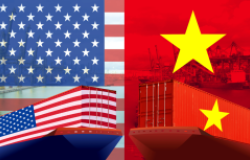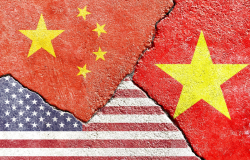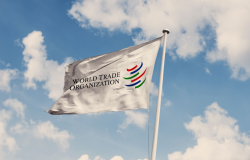Biden Kicks-off US-Mexico Economic Dialogue
Vice President Joseph Biden is in Mexico to officially launch the U.S.-Mexico High Level Economic Dialogue (HLED) as a reflection of the enormous importance of U.S. - Mexico relations. Program Associate Christopher Wilson discusses why this matters.

Five years ago, the United States and China launched the Strategic and Economic Dialogue, a reflection of the growing complexity and enormous importance of US-China relations. Earlier this year at their meeting in Mexico City, President Obama and President Peña Nieto agreed to a similar initiative, the US-Mexico High Level Economic Dialogue (HLED), for much the same reasons, and Vice President Biden is in Mexico today to officially launch the initiative.
Before looking at the content of the Dialogue, let’s take a quick look at why this matters:
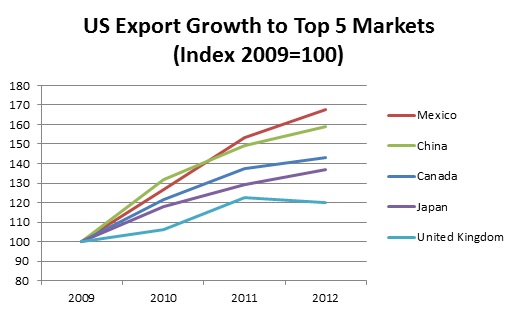
Source: United States Census Bureau, 2013
Mexico is the United States’ second largest export market (Canada is first), and since 2009, exports to Mexico have grown faster than exports to any of our other top trading partners. Some six million US jobs depend on trade with Mexico. Investment and financial flows between the two countries are also important, but the massive trade relationship is still the centerpiece of the economic relationship.
In addition to being big, trade with Mexico is also unique. Imports from China contain, on average, four percent US content. This is because most of the parts and materials in Chinese goods are either produced domestically in China or regionally in Asia. Imports of final goods from Mexico, on the other hand, contain an average of forty percent US content. US inputs are widely used in Mexican factories, which means any growth in Mexico’s manufacturing sector fuels growth in the US, and vice versa. A look at the chart below shows how closely linked industry on both sides of the border have become, and also how quickly production in Mexico has expanded in the years since the Great Recession.
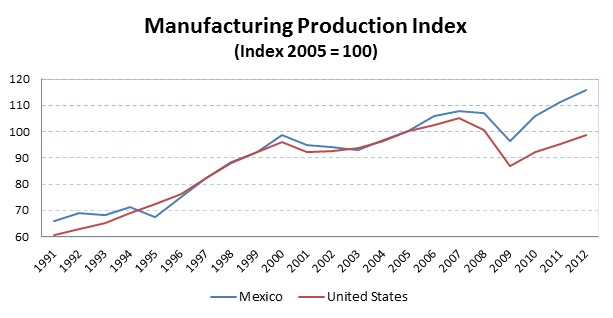
Source: Source: Organization for Economic Cooperation and Development, StatExtracts, 2013.
The HLED will be centered on three pillars, and the selection of these tells us a lot about the evolving nature of the global economy and especially the US-Mexico economic relationship.
Pillar 1.Promoting Competitiveness and Connectivity: What’s important here is the decision to put these two issues together. Back in the Nineties, NAFTA eliminated most tariffs on trade within the region and thereby stimulated a huge increase in commerce. The construction of transportation infrastructure, the highways and border crossings on which this trade travels, have lagged way behind the growing flows of goods and people. Increased border security following the terrorist attacks of 9/11 made the border an even greater bottleneck, and at this point infrastructure and border crossing issues have become a big drag on the competitiveness of manufacturers in the region. This is the local version of the worldwide transition from trade policy based on tariff reductions to one based on non-tariff barriers and the building of robust supply chains. Connectivity also refers to other areas of joint opportunity like telecommunications and electricity.
Pillar 2.Fostering Economic Growth, Productivity and Innovation: As technology and advanced manufacturing techniques have evolved, they have lowered the portion of production costs devoted to unskilled labor, and although many may still think of Mexican industry in terms Maquiladoras along the border pumping out cheap electronics, Mexico has slowly but surely climbed up the rungs of the value-added ladder, from sewing t-shirts and cobbling shoes to building cars and airplanes. So at this point, whether in the United States or Mexico, the formula for creating good, high-paying jobs is based on building human capital—increasing the knowledge and skills of workers. Instead of line workers, the US and Mexico need highly-skilled programmers, designers and engineers, and since our manufacturing sectors are deeply interconnected, we need them not only in the US or Mexico. We need them in both countries.
Closely connected to the HLED is an initiative that hits at the heart of these issues. The Mexico-United States Entrepreneurship and Innovation Council (or MUSEIC) is coordinated by the two governments but involves private sector representatives from both countries. Meeting regularly to discuss ways in which entrepreneurship and innovation affect competitiveness, sub-committees deal with a range of issues from tech clusters to the role of women in business. And the talks are not just at the abstract level: a meeting of the sub-committee on financing issues in July resulted in the signing of 35 deals between participants.
The Vice President will also touch on the theme of educational cooperation during his visit, an issue to which the Mexican government has attached great importance. Increasing university level exchanges between the two nations and improving human capital formation in both countries will be a crucial component in securing future competitiveness. Despite the depth of US-Mexico ties, there are currently less than 14,000 Mexican students studying in American universities, and Mexico ranks ninth among countries that send students to the United States for undergraduate education and tenth for graduate education, far below Turkey, Iran, and other smaller and more distant countries. Increasing educational exchange would help both countries achieve their human capital goals.
Pillar 3. Partnering for Regional and Global Leadership: In this context, trade is an especially relevant topic. The United States and Mexico are each in the midst of negotiating super-regional trade agreements, and given the integrated nature regional production, the US and Mexico have a great number of shared interests in these negotiations. It makes sense, then, for the two countries to negotiate as a bloc. Both countries are already parties to the negotiation of the Trans-Pacific Partnership, making it the perfect venue to begin such an approach. Mexico and the US would each also do well to consider inviting the other into the Pacific Alliance and Transatlantic Trade and Investment Partnership, respectively.
Within these three pillars, a number of specific programs will be developed. Some will be the next stage of ongoing projects, but several will be brand new. The topics of innovation and entrepreneurship, for example, are being added to the bilateral agenda for the first time. Domestic factors, like the economic reform agenda in Mexico and the battle over the budget in the United States, will always be the main determinants of each country’s economic competitiveness, but the new ideas being generated through the HLED, backed-up by the leadership of Vice-President Biden and the strong momentum behind the recent growth in US-Mexico trade, could provide both nations with a significant boost.
Christopher Wilson is an Associate at the Mexico Institute of the Woodrow Wilson International Center for Scholars, where he develops the Institute’s research and programming on regional economic integration and U.S.-Mexico border affairs.
About the Author


Mexico Institute
The Mexico Institute seeks to improve understanding, communication, and cooperation between Mexico and the United States by promoting original research, encouraging public discussion, and proposing policy options for enhancing the bilateral relationship. A binational Advisory Board, chaired by Luis Téllez and Earl Anthony Wayne, oversees the work of the Mexico Institute. Read more

